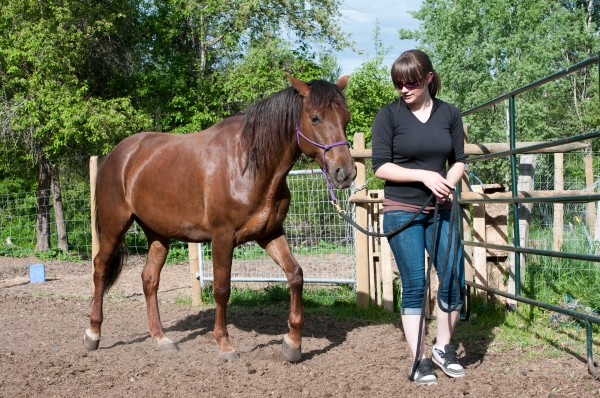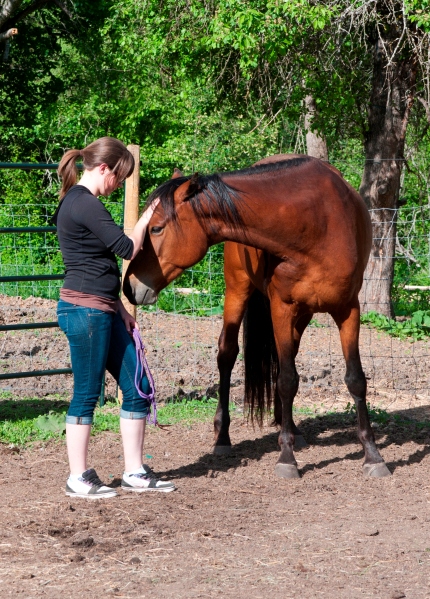This article may not be exactly what you expect. It is not a step by step method of how to halter train. And, it is not a list of things to do with every horse you are halter training.
Why? Because there really IS no specific method of halter training your horse.
All horses react differently to different pressures, rewards, and situations. We recently started halter training four mares (5-year olds), who all have different personalities, characters and emotions. These mares had quite a bit of handling without ropes, so they were friendly and relatively tame, but still had no understanding (and a little bit of fear) of what halters, ropes, sticks, etc. meant. The relationship was beginning, but the communication was not there.
What this article covers is my experience with all four of these different horses, and how I dealt with each of them differently in order to get them on their way to leading respectfully, calmly, and most importantly, fearlessly. I’ve included some key personality traits for each of them, so that you can read which one applies to your own horse and hopefully you can take away some ideas to work with and apply them to your own situations.
(Disclaimer: Keep in mind that there IS NO FORMULA for training, but there are certain measures you can take to set yourself up for success with a variety of personalities. These are examples of the ways I dealt with these horses’ personalities. They are in no way the only way to handle these situations. Please see our comment policies page for guidelines on any comments, questions or concerns.)
Smoky – black Morgan mare
Personality traits: “freezes” when fearful, explosive if pressured, confident in some aspects, very willing and friendly once you gain her trust
(Photo credit: Tim Cardinal)
Smoky was one of the most interesting of the group to work with on line. She is an odd combination of over-confident and extremely fearful. She also has an interesting way of expressing her emotions – when she becomes afraid, she will first “freeze” by gluing all four feet to the ground. If you pay attention to her eyes and ears, you can tell how much her fear grows with more and more pressure. When she reaches her threshold, she will suddenly EXPLODE in a flurry of jumps and rears. She would do this each time I put pressure on the halter, behind her ears.
It’s important to note that she was NOT misbehaving in any way when she did this little “dance.” I recognized that she simply didn’t understand, and as a flight animal, this misunderstanding turned directly into a fear-based response.
At first, I thought that the 12-foot lead line I use would scare her more, and tried using just my hand on the halter. After a few occasions of Smoky pulling me around, and in turn, becoming even more fearful because I was getting pulled AT her each time she reacted, I realized that putting the lead on would actually help her learning. (Sometimes, allowing the horse more “drift” helps them feel less trapped and actually will help them stay in the right state of mind to continue learning.) Since her brain flipped into survival mode each time she pulled me, the line allowed me to avoid getting pulled quite so much, and Smoky was therefore more easily able to stay in the right frame of mind.
Even after discovering the best methods to work with Smoky, she took the longest out of all of the mares to understand what she was being asked to do. The pattern didn’t change for quite a while: I would put pressure on her halter, she would “freeze,” then explode, and I would hold a steady pressure on the line and release when she came down from her rearing (this way, she was releasing her own pressure – when she came towards me, the pressure stopped).
But suddenly – Smoky had an “a-ha!” moment! Instead of REACTING to the pressure behind her head, she thought for a moment, and RESPONDED to the pressure instead. And again. And again. She finally had it!
(Photo credit: Tim Cardinal)
Verdict: With this type of horse, it is VERY IMPORTANT to give them the drift, patience and time it takes for them to grasp something. Once Smoky figured out what she was being asked to do, she HAD it. On the contrary, if I had pressured her too much and gone too fast, she could develop an emotional, explosive response to every request from then on. (We have a gelding related to her that was trained quite young, and was pressured a lot. He is a perfect example of what Smoky could be like with too much pressure – he is flighty and explosive, and he bucks when the saddle squeezes him.)
As natural horseman Pat Parelli would say – “take the time it takes so it takes less time.” This is especially true for horses like Smoky!
CoCo – sooty chestnut Morgan mare
Personality traits: trusting, laid-back, forgiving
(Photo credit: Tim Cardinal)
CoCo’s first experience with a halter was when she was three years old. It was not a great experience – we were forced to use a halter when she injured her back leg. Because she was untrained, and at that point still not even very tame, we had to shoo her and one other filly into a small chute/pen we had built so she couldn’t move away when we tried to clean her wound. One person would hold CoCo’s head with the halter, and the other would dress the wound.
Not the best way of doing things – but it was the only way we could treat her injury. Situations like this remind me of how important foal imprinting is. (These mares were acquired when they were two year olds, and they had next to no handling when we purchased them. Our experiences with them have encouraged us to handle our babies from day one.)
Once CoCo’s leg was healed enough, she was turned back out to pasture, and not haltered again for quite some time.
When she was handled again, she was of course not especially excited to see that nasty rope. To gain her trust back, we built a round pen near the house to keep her in for a while. Every day, my mom walked through her pen several times when going out to feed the horses. Eventually, once CoCo decided this was OK, we worked towards simply putting the halter on (and giving her a little treat once she had it on). CoCo started looking forward to getting her halter on, and by the end of a month of being in the round pen, she was leading like an old pro.
Again, CoCo was turned back out to pasture and not haltered for a while.
When I worked with CoCo again this summer, she had remembered all of her lessons from the second (good) experience. She was still leading like a champ!
Verdict: Even after a bad experience, CoCo’s forgiving personality allowed us to create a new, better bond with her. She is very trusting, and without that personality, we may not have been able to so easily regain CoCo’s trust. With horses like CoCo, you can afford to make some mistakes – a great personality for beginners!
Ginger – flaxen chestnut Morgan mare
Personality traits: not fully trusting, willing to try, very smart
Ginger is an interesting girl. She is somewhere between Smoky’s personality and CoCo’s personality – a little flighty, but still willing to try. She’s probably had the least handling out of all of these mares, so her flighty-ness may go away with more human contact. However, at this point, she is still in between trusting and not trusting people to keep her safe.
Ginger was probably the easiest of all of them to actually get the halter on. However, I had to approach her differently – I had to approach her in a very indirect, non-threatening manner, being careful to not directly face her when I walked towards her – that was too much pressure for her and she would run. However, when approached in the right manner, she was willing to try, and she stood still.
Once the halter was on, Ginger picked up the idea of leading very, very quickly. I think she pulled back only a couple of times, and then figured out that wasn’t what I was asking. After that, she was leading in the round pen, in her paddock, in and out of gates – any direction I asked her to lead in, she would go.
Verdict: Although Ginger picked the concepts I was teaching her very quickly, it will take many more hours to gain her full trust. She’s willing to try and fairly confident in herself, but she hasn’t developed confidence in people yet. More hours are all she really needs in order to develop a good relationship.
Cali – bay Morgan mare
Personality traits: a little bossy, very willing once you gain her trust
(Photo credit: Tim Cardinal)
Cali was the most different of the four mares to work with. At first, she was quite bossy, didn’t want to be caught, and would threaten to kick when I asked her to move her hindquarters over (without a halter on). She also seemed apprehensive of the halter altogether, and evaded me when I tried to put it on.
By taking it a bit slower, I was able to get the halter and lead on Cali’s head. Once the halter was on, she was much like Ginger – fast to pick up the concept of leading, without much pulling or confusion.
When I took the halter off, she was a different horse.
Cali is one of those examples of horses that completely change with a little bit of work. She now comes over for pets and love, and is not in the least bit bossy. I can even ask her to yield her hindquarters now with no questions asked.
Verdict: I think Cali was expressing her distrust by dominance. Once she decided I wasn’t a threat, she also decided that I was her “leader” and that there was no reason for her to try and dominate. Now that we’ve gained her trust, her continued training should be a breeze.
How have you halter trained in the past? How did your horse react or respond?




